The Beginner’s Guide to SEO Competitor Analysis
Freddy Barnes
Posted 3 October, 2019 by Freddy Barnes in SEO
The Beginner’s Guide to SEO Competitor Analysis
Unless you’re lucky enough to operate in a monopoly, competition will be an everyday part of your business. Online is no different. Knowing who you’re fighting for visibility in SERPs is the first step to building a watertight SEO strategy.
This post will explore how to find your competitors and analyse their backlink profiles. If all goes to plan, you’ll find weaknesses you can exploit and strengths you can use to inspire future campaigns.
To illustrate the process, we’ll be using an imaginary chemistry facts website as our ‘new’ site in need of a strategy. This site wants to rank for keywords including [chemistry facts], [chemistry revision] and [learn chemistry].
Finding the Competition
The first step in any competitor analysis is finding competitors to analyse. To do this the easiest way is to run a Google Search for your target keywords.

From these searches, we can identify our main SEO rivals. While these competitors may not necessarily offer the exact same things as our site, they all compete for the same key search phrases.
This is an important point: SEO competitors may not overlap with direct business competitors. Being aware of this will save you a lot of headaches further down the line.
Once you have your list of competitors, I recommend narrowing down to ten or fewer. This keeps the analysis manageable while still being in-depth enough to provide insight.
Competitor Visibility
Now you need to see which of these competitors are within reach and which are dominating currently. Splitting your competitors into two tiers can be useful; realistic ones you can target over the short to medium term, and ambitious competitors that’ll take sustained investment and effort to overtake.
The way to assess this is by looking at your competitors’ visibility in SERPs. SISTRIX is one tool that measures this metric, and the way it is calculated is as follows.
First, SISTRIX takes a sample of the top 100 search positions for one million keywords or keyword combinations. (As a comparison, the Oxford English Dictionary contains about 120,000 words). It then weights the results according to position and search volume for a keyword. (See here for more detail about the visibility index).

Enter your first competitor into the SISTRIX toolbar (we’ve chosen ZMEScience) and scroll to their visibility index. Next, click on the cog in the top right corner and then ‘Compare Data in Chart’. This allows a comparison of up to 4 websites’ visibilities. Enter the rest of your first batch of competitors and hit ‘Compare’.
You may have one visibility that’s so large that it doesn’t let you see the others clearly. If that’s the case, set it aside for now and replace with another competitor until you have a graph that’s readable. These will be our realistic competitors. The ones you’ve set aside will be your ambitious, longer-term competition.

Clicking the cog again and selecting ‘Show More Pins’ allows SISTRIX to show the dates of known Google algorithm updates. It’s interesting to note if any competitors have surges or drops in visibility that coincide with these dates.
From the above graph we can see that RevisionWorld (in blue) surged after the second Medic Update (pin M). Conversely, ZMEScience (red) has dropped dramatically after the June 2019 Core Update (pin O).
You can use this to inform your strategy; is there anything surging competitors are doing that you aren’t? Or is there something you’re getting away with, but another competitor has been hit for?
You can also use other tools to measure your visibility. Searchmetrics has a nice feature that allows you to see how many keywords you share with your competitors. As before, we’ve chosen ZMEScience to be our representative example.
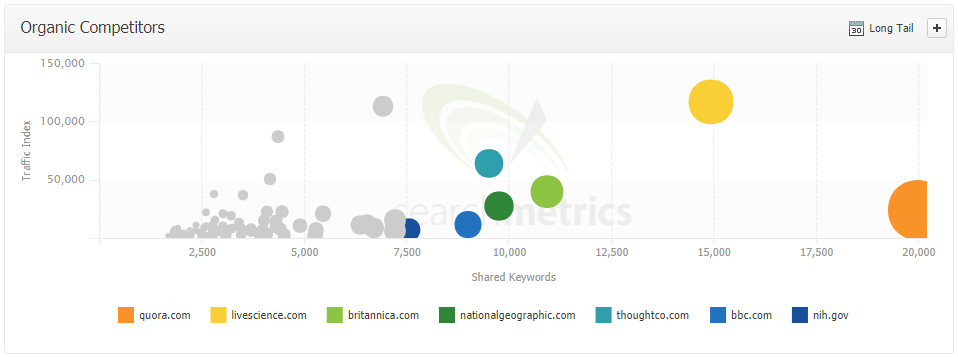
From this we can see that ZMEScience shares a lot of its keywords with a lot of high-authority sites such as the Encyclopedia Britannica and National Geographic. These would obviously be considered long-term competitors that we wouldn’t be able to target immediately.
Finally, SEMrush also shows something similar. Its Competitive Positioning Map shows competitors by organic traffic and the number of keywords they are ranking in the top 20 Google results for. The size of the bubble represents a website’s visibility in SERPs.

SERP Analysis
If there is one particular keyword that you are targeting, it can be worth analysing the SERP for this keyword. For example, what is the type of content ranking for this query?
The results that Google shows can give you insight into what it thinks the intent behind that search is. If the results are all guides, blog posts and listicles, then it is fair to assume that the intent is informational. People are looking for information in this instance, so to rank for this query you’ll have to provide that information.
Looking at the SERP for [chemistry facts], this is exactly what we get. All ten organic results are information pages, which shouldn’t really be surprising. People aren’t generally looking to buy facts. (But if you know someone who is, send them my way. I’ve got some good ones).
Moz’s SERP Analysis section contains useful metrics such as overall Keyword Difficulty, as well as individual Domain Authority and Page Authority scores for each result. Keyword Difficulty estimates how easy it is to rank above the current competitors for that query; the lower the score, the better.
The SERP analysis results can also be used to get an idea of what you might need to achieve to compete.
Using minimum and average metrics for the top ten results can be one way to do this. In this Google Sheet, I’ve created a SERP analysis template (in the tab imaginatively named SERP Analysis). You will need to make a copy before you can do anything.
Fill this in with the Domain and Page Authority for each result, as well as the number of Referring Domains to both the page and overall domain. You should see something like the following:
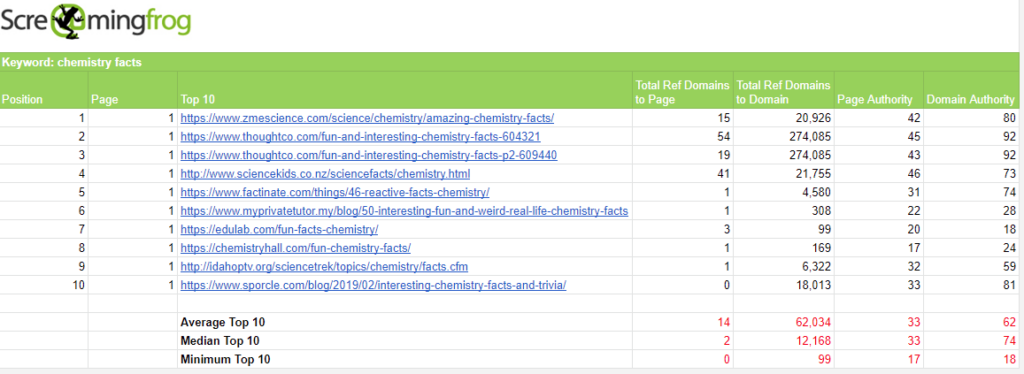
This gives the minimum and average for each of the metrics mentioned above. As we should anticipate, both the number and quality of referring domains is important in order to rank well.
These numbers should be taken with a heavy pinch of salt; we will not need 62,000 referring domains just to compete. In this case the very high number to ThoughtCo skews the averages high.
Nevertheless, it remains useful to see all the numbers in one place to give an overview of where your competitors are.
Backlink Profile Analysis
Now you can take a deeper dive into the backlink profile of your immediate competition. Using a mixture of metrics from three well-known SEO tools (Moz, Ahrefs and Majestic) allows a more detailed comparison than using any one alone.
When doing comparative work like this, it’s important to make it as efficient as possible. All three SEO tools have a comparison part where you can submit multiple URLs rather than doing it one-by-one.
Moz has its Compare Link Profile section under Link Research, Ahrefs has a Batch Analysis tool, and Majestic has a Comparator section. With Ahrefs, make sure you use the ‘Live’ index to make sure the data is as up to date as possible.
Note that you can’t directly compare numbers from different sources as they are calculated differently. It’s also worth noting that you should judge numbers relative to your site rather than in absolute terms.
Preparing a table like the below allows an overall look at each competitor’s backlink profile. It also makes it easy to note any outliers that you need to investigate further.

Out of the metrics, Referring Domains and Domain Authority (DA) are particularly important. We often see a large correlation between these and SEO performance.
Referring Domains is the number of separate websites linking to a given site, while DA (a score out of 100) is an estimation of the quality of these links.
From this, we can see that ZMEScience has by far and away the highest quality link profile. It has the highest number of Referring Domains and the highest DA. Therefore, it’s interesting to see from the visibility graph that it’s not as visible as RevisionWorld.
It is also worth noting that RevisionScience and RevisionWorld have nearly the same number of backlinks. These come from 200 and 1,500 referring domains respectively.
This implies that a large proportion of the backlinks to RevisionScience may be low-quality links, potentially due to mass submission or scraper sites. This should be a competitor our site should look to be challenging, but not replicating in terms of linking.
Link Quality
You can also compare competitors by link quality. In theory, links from domains with a higher DA (Moz) or Domain Rating (Ahrefs) score should pass more authority to the linked site.
Moz shows this by default, segmenting DA into batches of 10: 0-10, 11-20 and so on. You can see this in Moz’s Link Explorer. Simply input your competitor’s domain and hit enter. Scroll down and the bottom-right chart should look like the below (for ZMEScience).
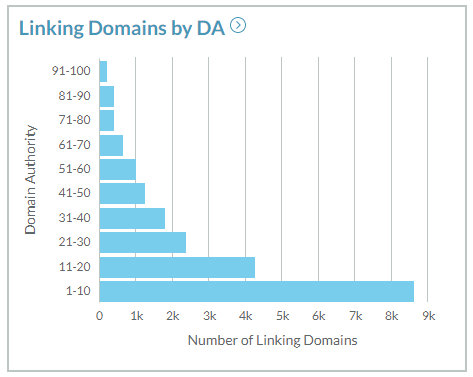
If you want to use Ahrefs to segment referring domains, it gets a little more involved. However, this has the advantage of being able to compare competitors side-by-side.
We segment the Domain Rating scores as follows:
- 100 to 70 – Most Valuable
- 69 to 50 – Valuable
- 49 to 30 – Average
- 29 to 0 – Low Value
To do this go back to your Ahrefs Batch Analysis and click on the Total number of Referring Domains for the top competitor. This will bring up the Referring Domains report for this website.
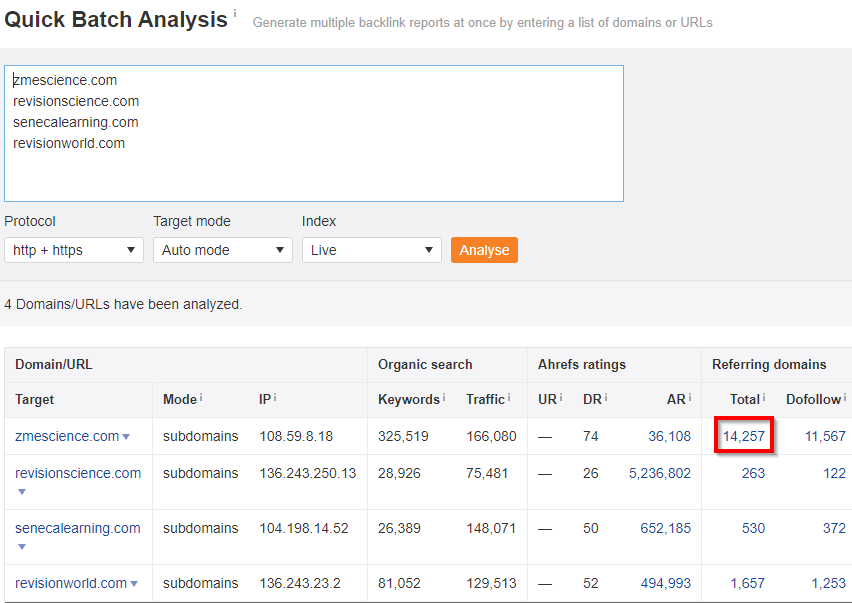
Export this to a CSV file, then filter Column C by the Domain Rating segments shown above. (Filter dropdown > Number Filters > Between…)
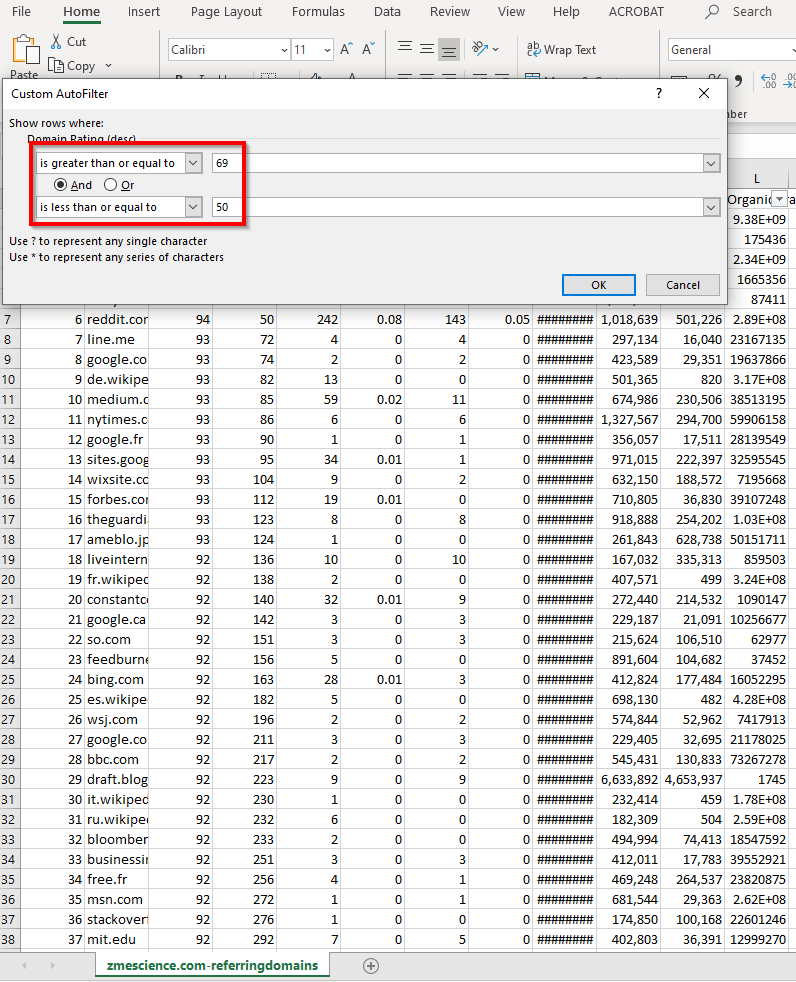
Make a copy of the Google Sheet template found here. Paste the number of overall Referring Domains for each segment into the template (Columns H onwards). Repeat this for all segments and all competitors until the chart is fully populated. For our science competitors, we see the following.
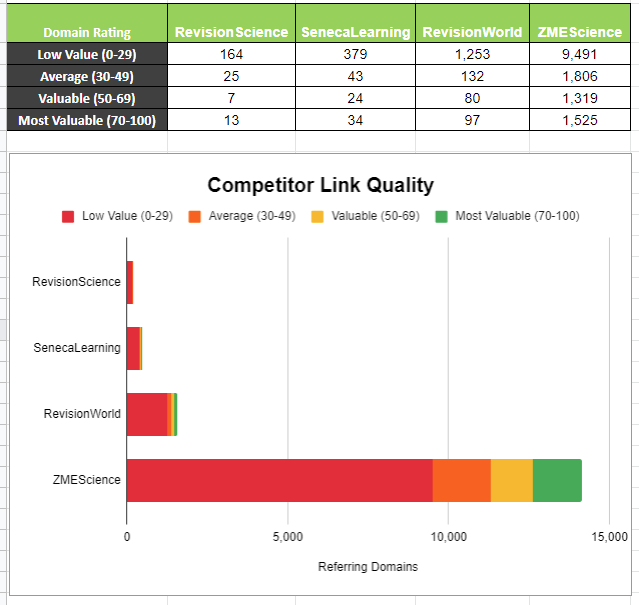
This visualisation allows a quick comparison of how many of each site’s referring domains falls under the segments described above. The proportions are also represented as a table in the template.

In this case, the table is clearer due to the comparatively high number of referring domains to ZMEScience. We can see the vast majority of the other sites’ referring domains are the lowest quality. This would suggest by targeting high-quality sites with our content, our new website would have an advantage.
Top Pages
Looking at a site’s most-linked to pages is a good way of understanding what linking work it’s been up to. If you can find out what works for your competitors, you can try something similar for yourself.
You can use the Best by Links report from Ahrefs to investigate this. (Enter domain or blog subfolder/subdomain > Pages > Best by links).
When looking at RevisionWorld, we see that one of its top pages is a revision calendar creator. This has 27 referring domains and over 1,700 dofollow backlinks.
Therefore, our new site could look at creating something similar, but even better. We could then target those sites that link to the now inferior content and ask them to link back to our new piece.
To find these sites to target, simply click on the number of referring domains in the Top Pages report.
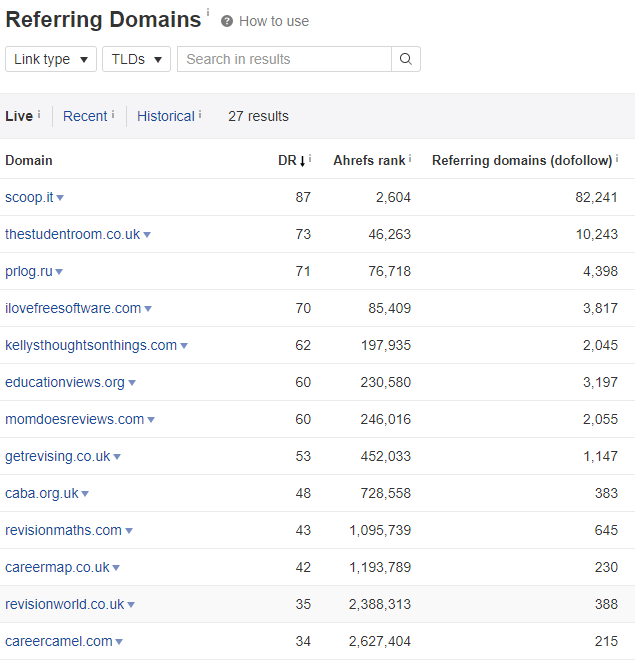
Link Growth
Finally, you can study competitors’ backlink growth. The rate at which they’re acquiring referring domains gives you a rough target to aim for with your site’s link building efforts.
Ahrefs’ Domain Comparison shows this in a visual way. Enter the URLs of your competitors into the boxes and hit ‘Compare’.
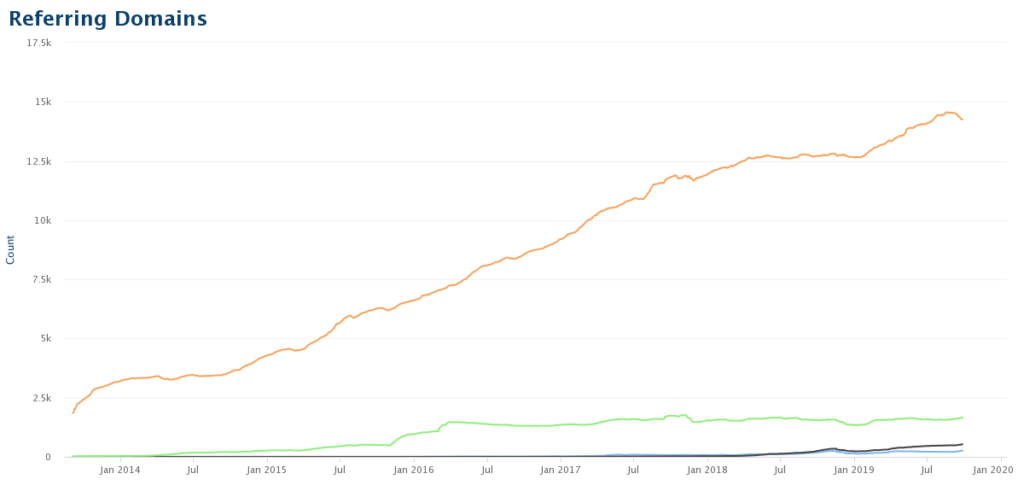

This shows at what rate competitors’ backlink profiles have been growing or declining.
Consistent growth, as seen for ZMEScience, can be natural or the result of long-term link building work.
RevisionWorld has experienced more inconsistent growth over the last five years. (I have removed ZMEScience for clarity – click its name in the legend to achieve this).
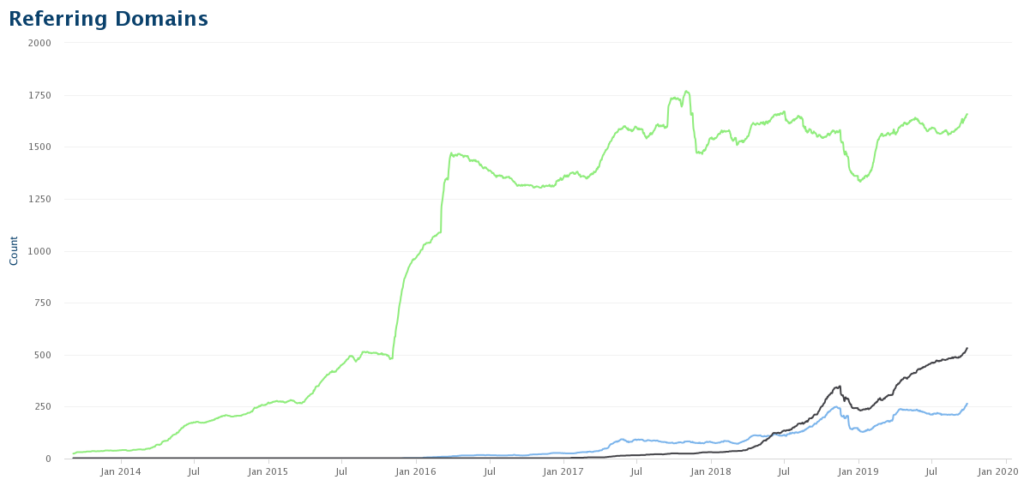

From this we can see rapid growth between October 2015 and March 2016.
By looking at Ahrefs’ New Referring Domains report (Enter domain > Referring domains > New), you can work out what might have caused this.
If most of the links point to the same page, then it’s likely down to a piece of content going viral. But if most of the added domains look spammy, it it’s more likely to be poor quality link building. It could also be due to low quality syndication sites which are usually present (to an extent) in most sites’ backlink profiles.
In RevisionWorld’s case, a lot of the new links with high Domain Ratings are .ac.uk, .sch.uk and .edu domains. These link back to revision guides on the RevisionWorld site.
This suggests they’ve had success outreaching their revision guides as an educational resource to schools and universities. This could be something our new site could look to replicate.
As seen earlier, this could be one reason why RevisionWorld is currently more visible in SERPs than ZMEScience. This is despite RevisionWorld having only a tenth of the number of referring domains.
Conclusion
The analysis above will help you find your SEO competitors and how to replicate their successes and learn from their mistakes.
As your site changes and grows, so will your competitors. You’ll need to keep tabs on who you’re fighting for SERP space with. Hopefully one day you’ll be challenging those ambitious competitors you identified way back at the start.






Great article about how to compare competition and how to get results, hovewer the tools you mention are so expensive if you would like use all 3 of them. Definitely is not for everyone. I agree the best method is to watch for competitors, teach on their mistakes and draw conclusions.
Probably the best way to have all these tools in a cost-effective manner is to choose a set of SEO products. I use Mangools (however, SemRush is also cool).
A great article. At the beginning of working with the client, I always optimize crawl budget. It’s nice to approach the matter. Indpirujace!
Keyword research and backlink profile analysis of competitors has evolved, fortunately. In a SEO project, in addition to a massive analysis of the presence of keywords and page variations and number of backlinks, today a more in-depth study of the site as a whole, a lot of user usability and the most important thing is needed. SEO, in my opinion, understand the user’s intent.
From this, tools like ScreamingFrog make a lot more sense because they help technically see how the site is doing. Understanding the user makes it clearer how the site should or should not be. Which content organization to have.
Fantastic article. Interesting tips!
Very comprehensive and useful insight, thanks for sharing.
Interesting article! Performing in -depth SEO competitor analysis is exactly what you need if you want to know where your competitor’s are ranked and see where you can improve to stay ahead of the competition. Also, you can get an idea how your competitor is promoting his website, allowing you to get a complete details of the the keywords and the linking domain. With this, you can start in the same manner. Thank you for sharing!
For backlink analysis which is the most important factor?
Domain Authority by MOZ, Trust Flow by Majestic or Domain Rating by Ahrefs.
Please suggest.
All these metrics measure the same thing in slightly different ways, so no one is better than any other and it’s mostly down to personal preference.
I personally prefer Ahrefs, but there’s no right answer here!
Such a Very helpful insight, thanks for sharing. Find competitors and analyse their quality backlink profiles is excellent way to create backlinks.
Thank you for this article. Very useful. As a beginner in SEO, this is quality info.
A very practical article that shows how to analyze competitors and on this basis determine the positioning strategy. Thanks!
As always Screaming Frog above the average, in this matter as a pro. Thank for another great content.
Thanks for this article! I’ve been using Screaming frog for quite a while, but with all the spare time I have in quarantine, I keep learning new stuff this tool is useful for (your Youtube channel is also very helpful). Thanks!
Good job! Thanks for this article!